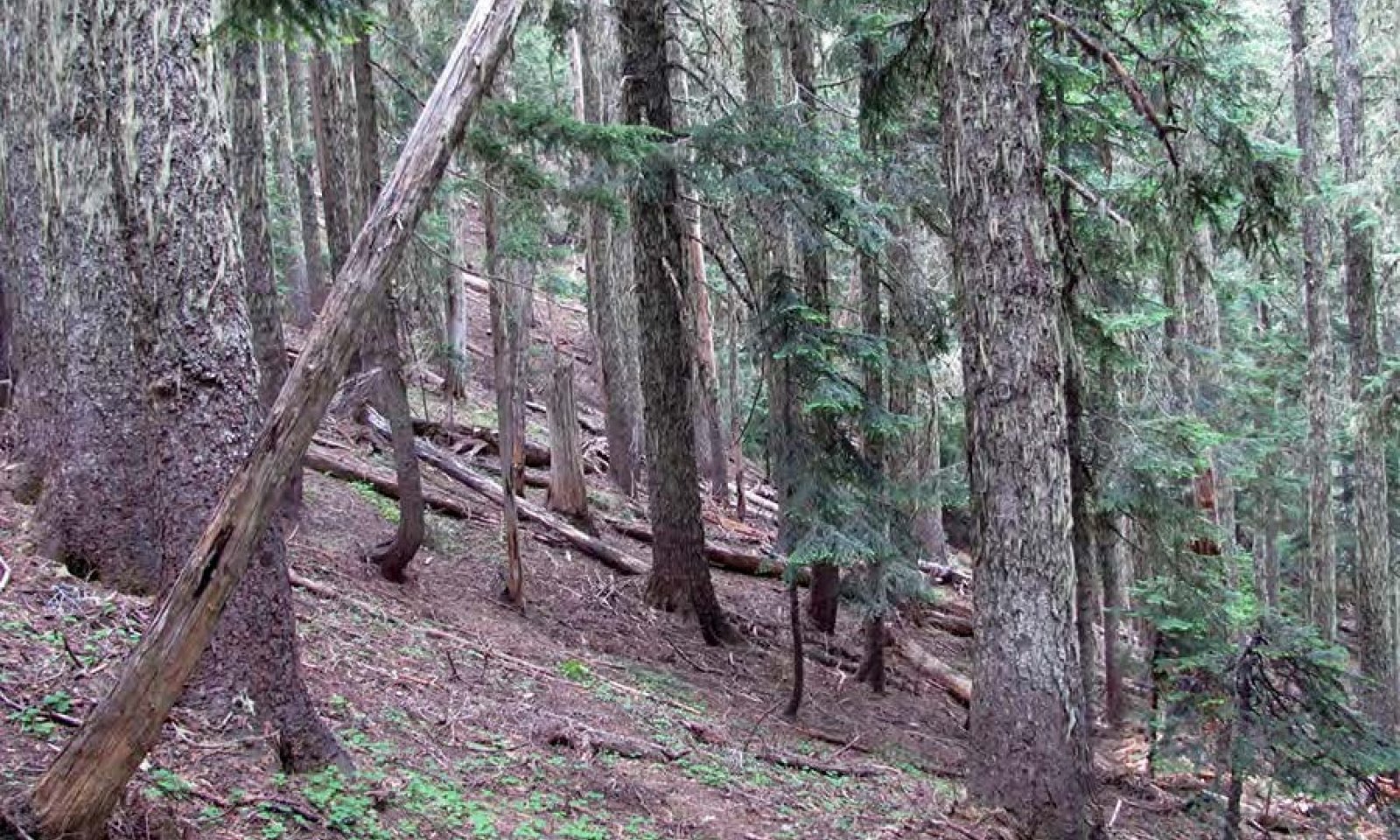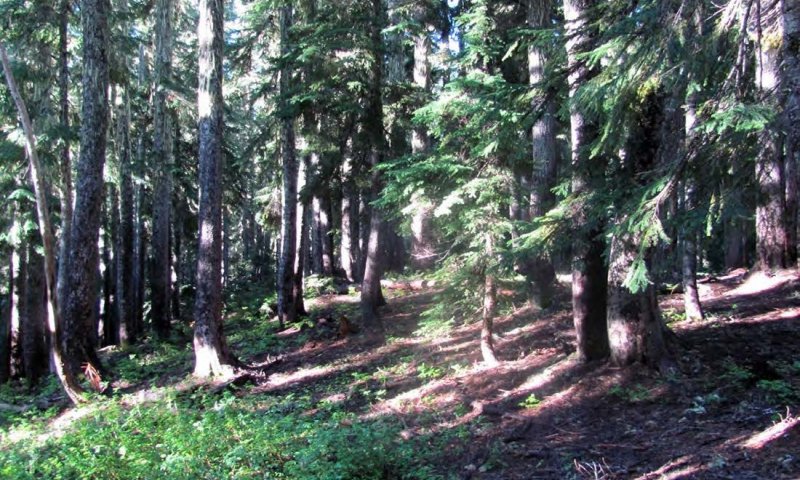Ecological dynamics
This ecological site is in cold, moist areas at high elevations (3,200 feet to 6,500 feet). The cold winters, deep snowpack, and mild summers impact the rates of growth and time to maturity. Fog and heavy cloud cover may provide necessary moisture in summer to areas along the timberline (Crawford, 2009).
The most common overstory species are mountain hemlock (Tsuga mertensiana) and subalpine fir (Abies lasiocarpa). Other common species include Pacific silver fir (Abies amabilis), noble fir (Abies procera), Alaska cedar (Callitropsis nootkatensis), and Engelmann spruce (Picea engelmannii).
Common understory shrubs include rusty menziesia (Menziesia ferruginea), black mountain huckleberry (Vaccinium membranaceum), Sitka mountain ash (Sorbus sitchensis var. sitchensis), and Cascade azalea (Rhododendron albiflorum). Common forbs include common beargrass (Xerophyllum tenax), Sitka valerian (Valeriana sitchensis), sidebells wintergreen (Orthilia secunda), smooth woodrush (Luzula glabrata), dwarf bramble (Rubus lasiococcus), and five-leaved bramble (Rubus pedatus). Regeneration commonly is limited by heavy snowpack at the higher elevations. Mature trees are on mounds in areas where the snow melts earlier than in other areas (Scientia Silvica, 1997).
Disturbances include forest pathogens, such as root rot, and high-intensity, low-frequency fires that are stand replacing. Mountain hemlock and Pacific silver fir are susceptible to laminated root rot (Phellinus weirii), which will result in patches of mortality. Subalpine fir is less susceptible, and Alaska cedar and whitebark pine (Pinus albicaulis) are tolerant. This fungus can alter the composition of the forest.
Because of the extended periods of snowpack at the higher elevation, the frequency of fire is relatively low. The fire regime for mountain hemlock and subalpine fir is 400 to 800 years. The wildfires commonly are stand replacing because of the dense forest canopy and the low, non-self-pruning branches of the trees (Tesky, 1992). Western white pine (Pinus monticola) commonly occurs as an early succession species after a stand-replacing fire.
Community 1.1
Mountain Hemlock, Subalpine Fir, Rusty Menziesia, and Common Beargrass
Structure: Multistory with small gap dynamics
Mountain hemlock is the dominant overstory species in the reference community, and it is the most shade-tolerant species. Subalpine fir, Pacific silver fir, noble fir, and Alaska cedar are subspecies. Reproduction of these species commonly is restricted under a closed canopy of mountain hemlock (Means, 1990). The dense canopy created by multiple age groups of hemlock may block most of the sunlight from the forest floor, which leads to sparse understory in some areas. Gaps in the mid-canopy and overstory allow sunlight to reach the ground. Most of the understory plants are in these areas. The understory is more continuous in areas where there is no mid-canopy. Common understory species include rusty menziesia, black mountain huckleberry, dwarf bramble, sidebells wintergreen, Sitka valerian, common beargrass, and pink mountain heather. The most common natural disturbance on this site is small gap dynamics following the death of some trees. From recorded plot data, the average diameter at breast height of mountain hemlock is 24 inches or more at an age of at least 300 years. The growing conditions of this ecological site limit timber production.
Tree islands are in the alpine areas of this community phase. The krummholtz forests of mountain hemlock and Pacific silver fir are in cold and windy areas along the timberline. The pockets of mature vegetation are 2 to 4 acres in size. The canopy cover in these areas is 25 percent to continuous. With a lack of disturbance and the general warming pattern of the climate in the Pacific Northwest, it is expected that the tree islands will regenerate and expand over time (Means, 1990). The rate of succession of subalpine fir into the overstory is higher in warmer, drier microsites that have an understory of heather (Phyllodoce) (Rochefort, 1996).
Community phase pathway 1.1A
This pathway represents minor disturbances, such as small pockets of root disease, individual tree mortality, and windthrow, that maintain the overall structure of the reference community. Mortality of individual trees or clusters of trees creates gaps in the understory that allow sunlight to reach the forest floor. This promotes the growth of forbs and shrubs and regeneration of overstory species and perpetuates the multi-storied, uneven-aged forest.
Forest overstory. Overall cover of mountain hemlock, subalpine fir, Pacific silver fir, Alaska cedar, and noble fir is 40 to 75 percent. The forest has multiple canopy layers. The upper canopy is 80 to 145 feet in height, and it averages 119 feet. The diameter of the trees varies depending on the species, but the average diameter at breast height is 19 inches. The diameter at breast height of noble fir typically is lower than that of mountain hemlock and subalpine fir. The canopy cover and basal area of the tree islands are lower than are those of the reference community.
Forest understory. The composition of the understory varies depending on the overstory cover and competition for sunlight and moisture. As the overstory community matures toward the reference state, the understory vegetation is less prevalent and more sparse. At the higher elevations, the density of the understory species is higher because the trees are less mature and the canopy is not closed. Overall cover of shrubs such as black mountain huckleberry, sidebells wintergreen, and white rhododendron is 1 to 55 percent. Dense pockets of shrubs develop in some areas. Overall cover of forbs such as common beargrass, Sitka valerian, five-leaved bramble, and arctic lupine is 1 to 30 percent.
Dominant plant species
-
mountain hemlock (Tsuga mertensiana), tree
-
subalpine fir (Abies lasiocarpa), tree
-
Pacific silver fir (Abies amabilis), tree
-
noble fir (Abies procera), tree
-
Alaska cedar (Callitropsis nootkatensis), tree
-
rusty menziesia (Menziesia ferruginea), shrub
-
thinleaf huckleberry (Vaccinium membranaceum), shrub
-
pink mountainheath (Phyllodoce empetriformis), shrub
-
common beargrass (Xerophyllum tenax), other herbaceous
-
roughfruit berry (Rubus lasiococcus), other herbaceous
-
Sitka valerian (Valeriana sitchensis), other herbaceous
Community 1.2
Mountain Hemlock, Subalpine Fir, Rusty Menziesia, and Common Beargrass
Structure: Mosaic of mature overstory and regenerating openings following root rot infestation
Community phase 1.2 has some areas that resemble community phase 1.1, but it also has moderate-sized openings (2 to 4 acres). Many of the shrubs, including rusty menziesia, common beargrass, dwarf bramble, and Sitka valerian, respond well to increased sunlight. This may delay or prevent reforestation of the openings.
Community 1.3
American Bistort, Fireweed, and Common Beargrass
Structure: Open meadow with snags
Community phase 1.3 is an early seral plant community that has been impacted by a stand-replacing disturbance such as a wildfire, large-scale windstorm, mass movement, or major insect infestation. Mountain hemlock is susceptible to damage from fire because of its low-hanging branches. It is not expected to survive moderate- or high-intensity fires; therefore, the fires are dominantly stand replacing (Tesky, 1992). Most of the trees are destroyed, but some fire-resistant trees may survive in the overstory. Standing, decaying snags are prevalent. The understory is dominantly shrubs and forbs such as American bistort, fireweed, common beargrass, and arctic lupine. Some grasses will establish, but they will be replaced by shrubs over time. Tree seedlings and saplings begin to establish within 3 to 10 years, depending on severity of the disturbance.
Community 1.4
Western White Pine, Subalpine Fir, American Bistort, and Arctic Lupine
Structure: Single story
Community phase 1.4 is an early seral forest in regeneration. Scattered remnant mature trees that are fire-resilient may be present. The species composition depends on the natural seed sources present and the intensity of the disturbance. Western white pine and subalpine fir are suited to reproduction after a disturbance (Means, 1990). After a moderate or severe fire, shrubs and forbs may outcompete tree seedlings. American bistort, arctic lupine, and partridgefoot, which may have been moderate in abundance previously, rapidly recover and spread when top-killed. This slows the regeneration of the overstory species. Tree species, including early successional species such as western white pine, commonly regenerate from an existing seed source. The stand is mixed and may include western white pine, Douglas-fir, mountain hemlock, and subalpine fir.
Community 1.5
Subalpine Fir, Mountain Hemlock, Purple Mountain Heather, and Arctic Lupine
Structure: Dense single story with diminished understory
Community phase 1.5 is a forest in the competitive exclusion stage. Scattered remnant mature trees may be present. Individual trees compete for available water and nutrients. The canopy closure is nearly 100 percent, which leads to a diminished understory. Some understory species better adapted to at least partial shade, such as Sitka valerian, increase in abundance. Over time, the forest will begin to self-thin due to competition. The species composition depends on the original seed sources available. The forest consists of a single species or mixed species, including subalpine fir, mountain hemlock, Pacific silver fir, Alaska cedar, and Engelmann spruce.
Community 1.6
Subalpine Fir, Mountain Hemlock, Rusty Menziesia, and Dwarf Bramble
Structure: Single story with few small openings
Community phase 1.6 is a maturing forest that is beginning to differentiate vertically. Individual trees are dying from competition, disease, insects, or windthrow, which allows some sunlight to reach the forest floor. The understory increases in abundance, and some pockets of overstory regeneration develop.
Pathway 1.1B
Community 1.1 to 1.2
This pathway represents a larger disturbance, such as a windstorm, insect infestation, or pocket of root rot. Areas of regeneration are 2 to 4 acres in size. Historically, this spatial pattern was caused by pockets of disease, such as annosum root rot (Heterobasidion annosum) or laminated root rot (Phellinus weirii); minor insect infestations; or low- to moderate-intensity fires. Because mountain hemlock is shallow rooted, it is susceptible to laminated root rot and windthrow (Tesky, 1992).
Pathway 1.1C
Community 1.1 to 1.3
This pathway represents a major stand-replacing disturbance, such as a high-intensity fire, large-scale windstorm, major insect infestation, or large mass movement. The frequency of fire is 400 to 800 years. Volcanic activity has the potential to disrupt the landscape ecology beyond the boundaries of the ecological site and the purpose of this site description.
Pathway 1.2A
Community 1.2 to 1.1
This pathway represents growth over time with no further significant disturbance. The areas of regeneration go through the typical phases of stands, including competitive exclusion, maturation, and understory reinitiation, until they resemble the old-growth structure of the reference community.
Pathway 1.2B
Community 1.2 to 1.3
This pathway represents a major stand-replacing disturbance such as a high-intensity fire, large-scale windstorm, major insect infestation, or large mass movement. This leads to the initiation phase of forest development.
Pathway 1.3A
Community 1.3 to 1.4
This pathway represents growth over time with no further major disturbance.
Pathway 1.4B
Community 1.4 to 1.3
This pathway represents a major stand-replacing disturbance such as a high-intensity fire, large-scale windstorm, major insect infestation, or large mass movement. This leads to the initiation phase of forest development.
Pathway 1.4A
Community 1.4 to 1.5
This pathway represents growth over time with no further major disturbance.
Pathway 1.5B
Community 1.5 to 1.3
This pathway represents a major stand-replacing disturbance such as a high-intensity fire, large-scale windstorm, major insect infestation, or large mass movement. This leads to the initiation phase of forest development.
Pathway 1.5A
Community 1.5 to 1.6
This pathway represents growth over time with no further major disturbance.
Pathway 1.6A
Community 1.6 to 1.1
This pathway represents growth over time with no further major disturbance. Continued growth over time and ongoing mortality lead to increased vertical diversification. The community begins to resemble the structure of the reference community, including small pockets of regeneration and a more diversified understory.
Pathway 1.6B
Community 1.6 to 1.3
This pathway represents a major stand-replacing disturbance such as a high-intensity fire, large-scale windstorm, major insect infestation, or large mass movement. This leads to the initiation phase of forest development.




